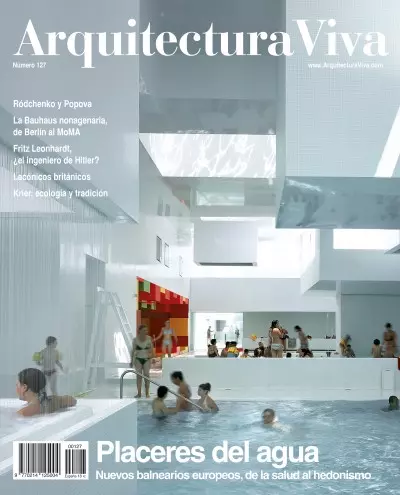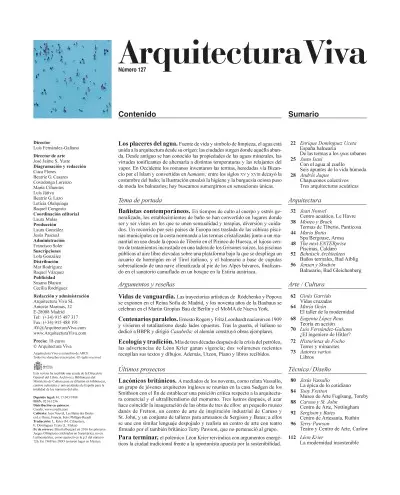Synopses
The Pleasures of Water. Fountain of life and symbol of cleanliness, water is linked to architecture since its origin: cities spring where water flows. Its mineral qualities are well known since ancient times, the invigorating virtues of alternating it at different temperatures and the relaxing ones of steam. In the West the Romans invented thermal baths, inherited via Byzantium by Islam in the form of hammams;?the custom of bathing waned between the 15th and 18th centuries; the Enlightenment praised hygiene and the bourgeoisie turned spas into fashionable places; today we seek submerging ourselves in unique sensations.
Contents
Enrique Domínguez Uceta
Thermal Spain
From Baths to Urban Spas
Justo Isasi
Deep in Water
Six Notes on Humid Life
Andrés Jaque
Collective Splashes
Three Aquatic Architectures
Contemporary Bathers .In these times of cult of the body and wide-spread stress, thermal bath facilities have become places for socialization, bring-ing together sensuality and therapy, entertainment and care. A journey through six European countries takes us from the cubic municipal swimming pools of the coasts of Normandy to the spa built by a spring which was already in use in times of Tiberius in the Pyrenees of Huesca, the luxurious therapy center tucked into a hillside in the Swiss Grisons, the public outdoor pools atop a platform that stretches over an aquarium of concrete in the Italian Tyrol area, and the thermal bath complex consisting of domes projecting from a heated hall at the foot of the Bavarian Alpes, ending at the life medicine resort camouflaged in the woods of the Austrian Styria region.
Jean Nouvel
Aquatic Center, Le Havre
Moneo & Brock
Tiberius Baths, Panticosa
Mario Botta
Bergoase Spa, Arosa
The next ENTERprise
Swimming Pools, Caldaro
Behnisch Architekten
Thermal Baths, Bad Aiblig
Jensen & Skodvin
Spa, Bad Gleichenberg
Views and Reviews
Avant-Garde Lives. The Reina Sofía Museum of Madrid covers the artistic careers of Ródchenko and Popova, and the Martin Gropius Bau of Berlin and the MoMA?of New York celebrate the ninetieth anniversary of the Bauhaus.
Art / Culture
Ginés Garrido
Vital Crossings
María Ocón
The Workshop of Modernity
Parallel Centennials. Ernesto Rogers and Fritz Leonhardt were both born in 1909, and experienced totalitarianism from opposite sides. After the war, the Italian joined BBPR and edited Casabella;?the German built noteworthy works.
Eugenia López Reus
Theory in Action
Luis Fernández-Galiano
Hitler’s Engineer?
Ecology and Tradition. More than three decades after the oil crisis, the warnings of Léon Krier gain relevance; two recently published volumes collect his writings and drawings. Piano, Utzon and books received close the section.
Focho’s Cartoon
Towers and Minarets
Various Authors
BooksRecent Projects
Laconic Brits. In the mid-nineties, as Vassallo describes, a group of young English architects gathered at the Sudgen House of the Smithsons with the aim of defining a critical stance regarding the commercial architecture and the ultraliberalism of the time. Fifteen years later, chance has decreed that the works of three of them be inaugurated at the same time: the small Danish museum by Fretton, an art center of industrial character by Caruso & St. John, and a series of arts and crafts workshops by?Sergison &?Bates;?the section is rounded off with an art center and theater that displays a similarly bare and realistic language, and that was designed by Terry Pawson, not a member of the group.
Technique / Style
Jesús Vassallo
The Epic of the Everyday
Tony Fretton
Fuglsang Art Museum, Toreby
Caruso & St. John
Art Center, Nottingham
Sergison & Bates
Craft Center, Ruthin
Terry Pawson
Theater and Art?Center, Carlow
To close, the polemical Léon Krier uses forceful arguments in favor of the traditional city in times of opportunist commitment to sustainability.
Léon Krier
Unsustainable Modernity
Luis Fernández-Galiano
The Pleasures of Water
If yesteryear bathing meant health and cleanliness, today it means pleasure. The historian of technique Sigfried Giedion described the historical evolution of the bath between the two poles of rejuvenation and hygiene: either as a means to regenerate the human body, or as a device for personal grooming. The immersion in hot or cold water served to restore bodies worn out by disease or age, and was also used to remove everyday dirt from the skin or hair. The discovery of germs united both functions, and health and hygiene have since become inseparable, as the twin purposes of regular bathing. However, today we put our health in the hands of medicine, and entrust daily hygiene to the perfunctory shower – initially conceived as a mechanization of washing developed in the collective context of barracks –, whereas the bath is reserved to the sensual pleasures of self-absorbed hedonism.
The modern plumbing revolution, which replaced the washing furniture of bowls and jars with sanitary fittings, turned episodic bathing into a frequent practice, and generalized in the domestic realm what until then had taken place in thermal or public baths, thus fragmenting in individual or familiar precincts the social or communal nature of the spaces of water. This gradual cloistering and privatization of healthy immersion increasingly diminished the importance both of the urban bathhouses and of spas linked to thermal springs, spaces of spontaneous socialization that ended up being associated to specific minorities or to older sectors of the population. But currently we are witnessing a boom of urban spas and thermal baths in natural environments that are addressed to a new public, eager to pursue well-being and also in permanent search of experiences, understood as a new form of consumption.
If the contemporary refurbishment of traditional thermal facilities, these days no longer based on the therapeutical virtues of ‘taking the waters’, entails a welcomed rescue of the bath for the collective realm, it is at the same time a sign of the extension of the cult of the body in our opulent societies. This healthy hedonism, which leaves behind ages of negation and repression, is at the same time a reflection of golden decadence, and also a mark of the prosperity and leisure of the West, which contrasts with the hygienic and sanitary shortages in many destitute regions of a world whose horizons already herald the new water wars. These conflicts, parodically summarized in Spain’s sad regional struggles over the river basins, recall the scarcity and the unequal access to this vital resource that indelibly mark the global biopolitics of water, whose undeniable pleasures cannot make us forget our no less evident privilege.








